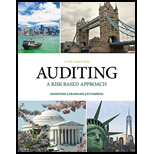
Introduction:The audit approach is the strategy for conducting an audit by the auditor. The approach varies with different clients, depends upon the number of factors like the nature of the business, the level of cooperation, the adequacy, etc. The planned audit approach should be effective and efficient. The assessment of control risk determines the audit approach.
Requirement 1
To ascertain:Out of the two auditors, the right one or both
Introduction:Audit approach is the strategy for conducting an audit by the auditor. The approach varies with different clients, depends upon the number of factors like the nature of the business, the level of cooperation, the adequacy, etc. The planned audit approach should be effective and efficient. The assessment of control risk determines the audit approach.
Requirement 2
To ascertain:The assertion is tested by the second auditor
Introduction: The audit approach is the strategy for conducting an audit by the auditor. The approach varies with different clients, depends upon the number of factors like the nature of the business, the level of cooperation, the adequacy, etc. The planned audit approach should be effective and efficient. The assessment of control risk determines the audit approach.
Requirement 3
To ascertain: The dual purpose test
Trending nowThis is a popular solution!

Chapter 9 Solutions
Auditing: A Risk Based-Approach (MindTap Course List)
- Kendrick Manufacturing Corp. (KMC) has total assets of $600 million, $80 million of which are cash. It has total debt of $250 million. If KMC repurchases $30 million of its stock, what changes will occur on its balance sheet? What will its new leverage ratio be? Please provide the accurate answer to this financial accounting problem using valid techniques.arrow_forwardNot use ai solution please and accounting questionarrow_forwardFinancial Accountingarrow_forward
- Provide answer pleasearrow_forwardHello tutor provide correct answer this general accounting questionarrow_forwardGiven the following information: Average Cost per Unit: Direct materials: $12.00 Direct labor: $7.00 Variable manufacturing overhead: $4.00 Fixed manufacturing overhead: $10.00 Fixed selling expense: $6.00 Fixed administrative expense: $5.00 Sales commissions: $4.00 Variable administrative expense: $3.00 Assuming the cost object is units of production, what is the total indirect manufacturing cost incurred to make 40,000 units?arrow_forward
 Auditing: A Risk Based-Approach (MindTap Course L...AccountingISBN:9781337619455Author:Karla M Johnstone, Audrey A. Gramling, Larry E. RittenbergPublisher:Cengage Learning
Auditing: A Risk Based-Approach (MindTap Course L...AccountingISBN:9781337619455Author:Karla M Johnstone, Audrey A. Gramling, Larry E. RittenbergPublisher:Cengage Learning Auditing: A Risk Based-Approach to Conducting a Q...AccountingISBN:9781305080577Author:Karla M Johnstone, Audrey A. Gramling, Larry E. RittenbergPublisher:South-Western College Pub
Auditing: A Risk Based-Approach to Conducting a Q...AccountingISBN:9781305080577Author:Karla M Johnstone, Audrey A. Gramling, Larry E. RittenbergPublisher:South-Western College Pub


